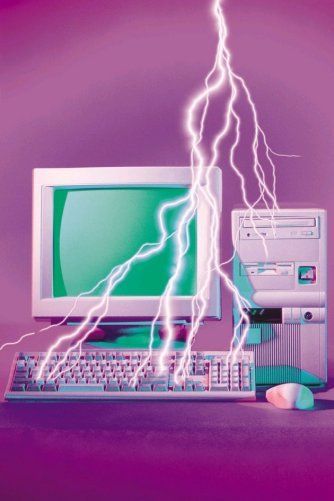Surge Protectors: How They Work
& Why They Can Fail
How Surge Protectors Work
A surge protector is a device designed to protect electrical equipment from voltage spikes. These surges can originate from:
- Lightning strikes
- Utility grid switching
- Power outages and restorations
- Large appliance cycling (HVAC systems, arc welders, etc.)
What Does a Surge Protector Actually Do?
Think of a surge protector like a bouncer at the door of a nightclub. Its job? Let the safe voltage in, and block or divert anything dangerous.
Components Inside a Surge Protector
Metal Oxide Varistor (MOV): Diverts excess voltage.
Thermal Fuse: Disconnects the MOV if it overheats.
Indicator Light: Shows if the surge protection is active.
Heavy Duty Inductors: blocks high-frequency spikes and electromagnetic interference critically, and with lightning, arc welders, etc.
VHF Capacitors: While MOVs absorb large surges, capacitors smooth out smaller, rapid fluctuations in voltage, stabilizing the power line
The key component doing this is something called a MOV—that stands for Metal Oxide Varistor. When the voltage spikes, the MOV absorbs or redirects the excess electricity into the electrical grounding system.
Basic Function:
1. Power flows through the MOV under normal voltage conditions.
2. If voltage exceeds a preset limit (e.g., 330V), the MOV becomes conductive.
3. It shunts the extra voltage to ground, preventing it from reaching your electronics.
Limitations:
- Surge protectors wear out. They silently degrade after absorbing multiple surges. If the indicator light is off, the protection may be gone even if power still flows. Cheaper surge protectors, however, will show a power light on even when all the protective circuitry has completely failed.
- The amount of electrical energy simply exceeds the ratings and protective capacity of the surge protector, especially with lightning.
- The speed of the electrical surge-surge protectors and fuses have a rating of speed of how quickly they can respond to a voltage disturbance. Some things, such as lightning, are simply too fast.
- Improper grounding-surge protectors and UPSs all depend on proper, grounded wiring in the building. Poor or missing grounding, miswiring, etc. can prevent surge protection.
- Interconnected equipment- some with surge protectors, and some without, can broadcast the surge into the unprotected pieces via cabling, Internet wiring, etc.
- Not all surge protectors are created equal. Some so-called surge protectors such is available at Big Box stores are little more than extension cords with minimal circuitry inside which quickly wears out.
Summation
While surge protectors may be used on electronic equipment their use is no guarantee of solid protection every time. Property claims involving these devices should be reviewed including other issues such as improper grounding, collateral damage, etc.






